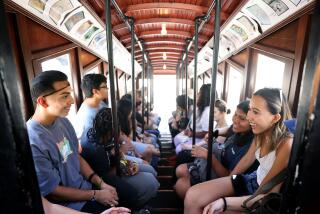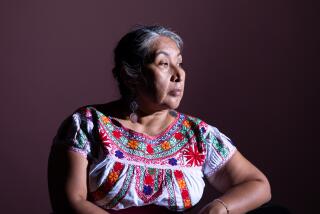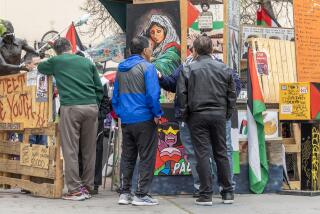Tongva, L.A.’s first language, opens the door to a forgotten time and place

Tongva, the language of the first people who lived in the Los Angeles region, slowly disappeared after Spanish expeditions reached California. UCLA linguist Pam Munro teaches a Tongva language class in an effort to keep it alive.
TOVAANGAR
“The world.”
From the top of Signal Hill, Los Angeles disappears in the haze. Gauzy light smudges details, so that only the mountains, the sea and the land in between remain. No freeways; no homes, high-rises or palms.
Off the coast lies the broad silhouette of Catalina. To the west rises Palos Verdes; to the east, Saddleback; and to the north, a curtain of peaks from Malibu to San Bernardino.
Tovaangar.
The word is hard to pronounce, three syllables, the accent falling on the second and the ng pronounced as in “singer,” not “finger.”
To-VAA-ngar.
Literally, it means “the world,” this hill and everything around it, as seen through the eyes of the Tongva, the first residents of the land.
This world was theirs before it belonged to anyone else, before strangers arrived and began to bend the region to their will and Tovaangar disappeared.
Smoke no longer rose from signal fires, chewee’et chaavot. The tall grass, mamaahar, vanished. Rivers, papaaxayt, changed course, and stars, shushuu’ram, faded from the sky.
The world, once identified by only their words, was unrecognizable, and the Tongva language eventually stopped being spoken. In the silence, it lived in notebooks and papers collected by museums.
It recently surfaced, however, on a Facebook page with a Soundcloud link, and today it is taught in a classroom in San Pedro where students are working to reclaim its place in the world.
Their efforts are faltering, shy and occasionally beautiful.
“Wereechey chinuuho,” adults and children sing in unison, “‘epeekmok she’iinga.” (The itsy bitsy spider climbed the tule stalk.)
Each month they gather, practicing pronunciation, mastering the use of particles, singing songs and playing word games under the guidance of Pam Munro, a linguist from UCLA who has been teaching these classes for 15 years.
She calls her work “a reclamation effort” for a language that is no longer used in conversations. She avoids calling Tongva extinct; that, she said, is a hurtful pronouncement upon a culture that still exists and a world that in the eyes of many has never disappeared.
Like a detective following clues, Munro studied the work left by earlier linguists and ethnographers and slowly reassembled Tongva.
Much is irretrievable, but in this classroom — in the intonation of words and the careful assembly of phrases — lies an invocation of another time and place.
Back then, the view from Signal Hill was of prairies and estuaries, of rivers cutting channels to the sea and mountains rising from the collision of ancient faults.
Tovaangar.
::
TAMAAWOT CHE’EENAX
“The mockingbird is singing.”
Munro stands at a whiteboard covered with words, circled letters, arrows, boxes within boxes.
Her students come from as far as the San Fernando Valley and Orange County. The oldest is 71, and the youngest, ages 6 to 11, are the grandchildren of two women of Tongva heritage.
Munro, 71, has studied the native languages of Southern California for nearly four decades.
She values clarity and precision to a point that might seem severe, but she leads each lesson with a thoughtful, collaborative energy, working with students as if Tongva could be shared with friends and neighbors.
Today she’s trying to form the word for “teacher.” There are expressions and words in Tongva — thank you, think, punish, rest, equality — that either were never recorded or never existed. They must be created, based on what is known of Tongva grammar and usage.
“We have the verb ‘know,’” she says, thinking out loud. “Hyoonax.”
She writes on the whiteboard: pavaaynax (“give water to”) and ‘ashuuynak (“bathe”).
She circles the yn.
“Yn,” she says, “is causative. If we created a word for ‘to cause to know,’ we would need to put a yn in it.”
The class follows her lead and constructs hyonaayn’ar for “teacher.”
Munro grew up in upstate New York and moved to Riverside when she was 16. Her parents were librarians at the university. As an undergraduate at Stanford, she was a history major and a self-described language junkie with a knowledge of French, Italian, German and Russian.
“She experiences linguistics as a series of puzzles. That’s different than learning a language,” said Allen Munro, her husband of 50 years, who is also a student in the class. “She is always trying to figure out what’s going on inside these languages.”
At UC San Diego, she wrote her dissertation on Mojave, the language of the people of the Colorado River.
At the time, the 1970s, the study of the native languages of California was experiencing a renaissance — “groundbreaking and exciting,” she said — and guided by her mentor, linguist Margaret Langdon, Munro set out to work with native speakers to document and record the fundamentals of these languages.
“Finding out new things about a language that nobody has analyzed before, from a linguist’s point of view, that is what excited and grabbed me,” she said. “It is the most incredible high: figuring out how the language works and making good friends at the time.”
But Munro never imagined herself studying the Tongva language, known at the time as Gabrieleño. Unlike Luiseño, the first California language she had studied, Tongva had no native speakers.
Then one day in the late 1970s, she received from a colleague five file boxes with 4-by-6-inch slips of paper containing hundreds of notes on Tongva, research from a former student compiled from the work of an earlier linguist.
Reading through these slips, she felt a responsibility to understand Tongva and its language family.
But just words and sounds were not enough.
She needed to find the grammar.
::
HYAA’MO PAKOORO TAAMET
“The sun is going to set now.”
Their villages once dotted the flood plain of Los Angeles and Orange counties. Seasonal camps extended into the foothills. Settlements lined the coves of Catalina.
Surrounded by other tribes — Chumash, Tataviam, Serrano, Cahuilla, Luiseño — the Tongva traded with one another, intermarried, learned their languages.
Historians estimate that by the time the first Spanish land expedition reached California in 1769, there were nearly 100 Tongva villages, nearly 5,000 Tongva people. (Estimates put the Tongva population today at about 3,000.)
Five years later, Mission San Gabriel was founded, then came Mission San Juan Capistrano and Mission San Fernando, and Tovaangar began to change. The Tongva were named Gabrieleños by the priests, and in 1826 a visitor to the mission described their lives: “They are kept in great fear, for the least offense they are corrected, they are complete slaves in every sense of the word.”
The story was eventually repeated among other tribes throughout California, and one of the most culturally diverse regions of the world was subsumed into an Spanish-Mexican-American hybrid. Of the 90 or so languages that flourished here, between a dozen and 30 are still spoken. For Native Californians, the loss is devastating.
“Language is ethnicity,” said linguist David Bellos. “Language identifies you; it informs listeners who you are.”
What took place more than 150 years ago was nothing less than a cleansing, and into this void stepped John Peabody Harrington, who in the first half of the last century began compiling notes on the native languages in California.
He saw it as his duty, Munro said, to record all the languages in the world. “We’re lucky he started in California,” she added.
Harrington and naturalist-turned-ethnologist C. Hart Merriam, working independently with the remaining speakers of Tongva, assembled a written record of the language. Merriam died in 1942, and Harrington, who lived until 1961, stopped working with Tongva speakers in the late 1930s. Their legacies stand in contrast to the crimes of earlier generations.
“Translating — what happens when someone thinks that someone else is worth talking to — is a first step toward civilization,” Bellos said.
Their work, however, was incomplete. There are no audio recordings of spoken Tongva, just a few scratchy wax cylinders of Tongva songs, a translation of the Lord’s Prayer and an 11-word story, the longest extended expression in Tongva, as cryptic as a haiku:
What is that dead body?
A man?
A woman?
A woman.
Encouraged by William Bright, a colleague at UCLA, Munro began working with these fragments. Looking at Harrington’s collection of random Tongva phrases, she looked for patterns in the use of verbs and nouns. She analyzed how the grammar worked and was able to construct her own sentences.
The structure was simple, like “The man is here.”
What was missing were dependent clauses, like “The man whom I saw is here.”
“We don’t have evidence about those,” she said. Harrington didn’t seem interested in asking. “It’s very sad.”
::
HUUTOKRE
“I see you.”
In 2004, Munro took what she had learned to a conference at UC Berkeley. Called the Breath of Life, the gathering linked linguists with Native Californians whose languages are no longer spoken.
Meeting with attendees, she realized how unprepared she was.
The people she worked with wanted to pray. They wanted to pray in Tongva.
Munro had to change her thinking. Linguists, she said, want to talk about pronouns and learn how to construct sentences. They are typically more interested in language as a puzzle than expression, so she stayed up one night creating a dictionary conference participants might use.
She also saw an opportunity. Tongva would no longer be a museum piece.
“A lot of people feel if they can pray or make up thoughts in the language of their ancestors, it will make them feel closer to their ancestors,” Munro said. Today they are able to offer such prayers.
Virginia Carmelo was one of Munro’s first students and recalled her surprise upon learning that the Tongva language existed. Carmelo, who is part Tongva and Kumeyaay, was raised in Orange County and has no memory of her family speaking Tongva.
When the workshop was over, Carmelo and another student asked if Munro would continue the lessons. They began to meet once a month in San Pedro, and their circle slowly grew.
Carmelo, 69, continues to attend classes, bringing her four grandchildren.
“Any aspect of our tribal culture that we can grasp on to will reinforce who we are as a people,” she said.
Tina Calderon, who identifies as Gabrieleño-Tongva and Chumash, started coming to class in 2017. She brings her grandson.
Tongva, she said, is more than a bridge to her ancestors; it is a bridge between two cultures, allowing her to live in both Los Angeles and in Tovaangar without having to hide her heritage.
“My grandpa identified as Mexican,” she said. “It was the only way he could get work.”
Chase Brown has studied Tongva for four years. Brown, 29, lives in Rancho Santa Margarita with his parents and uses the language to be closer to the native habitats of Southern California. He describes speaking Tongva in the wilderness.
“I’ll say pakiishar — hawk — and I will feel a shift around me,” he said, “as if there is a memory in the land itself that is connecting with the words.”
Tongva has brought Brent Scarcliff closer to understanding Southern California.
After class, he drives home to Redondo Beach, taking the long way around Palos Verdes. Gazing out across the Catalina Channel, he has come to understand why the Tongva felt that paradise lay just beyond the glimmering of light and fog.
“Tongva has helped me know what California was like hundreds of years ago,” he said, “but also to look at California with a more mystical sense of attachment. It is not just a place I happen to be in but a place full of power and meaning.”
::
MIIRE ‘EYOOMA’
“We are going.”
On a cool Sunday morning, the students gather in the parking lot of the Santiago Park Nature Reserve in Santa Ana. The sun shines on a road called Memory Lane, and the nearby freeway provides its steady swoosh.
They have come here in search of another time and place. They hope their words will cast the right spell.
“This is a good place to cultivate a relationship with nature, especially with the language that was once spoken here,” says naturalist Joel Robinson, their guide today.
Dressed in black with a necklace featuring an abalone shell pendant, Munro hands out a short list — in English and Tongva — of native plants and animals.
Under broad-brimmed hats, the class follows a narrow path on its linguistic scavenger hunt.
“Naavot,” Robinson says. “Naavot xaa maneema’. This is a prickly pear cactus.”
Everyone repeats the word and phrase.
“Paa’or,” he says, pinching a leaf and allowing the smell of sage to flood the trail.
The words are soon falling among the class.
“Sheveer,” he says, pointing to the sycamore.
Munro corrects the pronunciation. “The e in the first syllable is pronounced eh,” she says.
Words begin to flow among the students.
A dog approaches them, woshii’.
A goldfinch flits in the brush.
“Paaxarengar cheyuu’,” someone says. “The sunflower bird.”
The class pauses over an interpretive sign that identifies the California ground squirrel as Spermophilus beecheyi, named by John Richardson in honoring Frederick William Beechey, an early 19th century British explorer and naval officer.
They search for the Tongva equivalent.
Someone points to a lizard.
“Chiruuko’,” they say.
At 11:40, the Amtrak Pacific Surfliner breezes by.
The students paused beneath an oak tree, wiit.
Some of them start climbing, and they pose for a group photo.
Joe Calderon, Tina’s husband, pulls out a gourd rattle and begins singing. He taps his toe, slightly swaying, repeating the lyrics.
“Taamet pakook.”
The sun is rising.
“Huunar kii.”
The bear is coming.
By 2 p.m. the class is back in the parking lot.
“‘Aweeshkore xaa,” someone proposes, and they nod.
We are happy.
Twitter: @tcurwen
More to Read
Sign up for Essential California
The most important California stories and recommendations in your inbox every morning.
You may occasionally receive promotional content from the Los Angeles Times.











